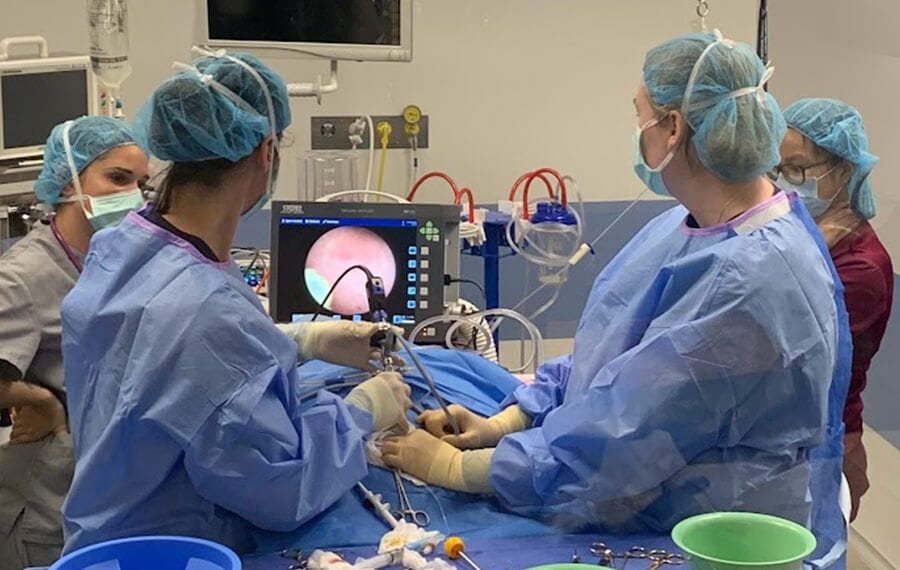When a pet’s ureter (the tube that carries urine from the kidney to the bladder) becomes blocked, urgent intervention is needed to restore kidney function and relieve pain. At VSOS, we offer Subcutaneous Ureteral Bypass (SUB) as a minimally invasive, highly effective surgical solution for cats and dogs with ureteral obstruction due to stones, strictures, or other causes. Our specialist-led team is one of the few in the region with the expertise and equipment to perform this advanced procedure.
What is a Subcutaneous Ureteral Bypass (SUB)?
A life-saving option for pets with ureteral obstruction.
What the service involves
A SUB system is a small, soft device that diverts urine flow from the kidney directly into the bladder, bypassing the blocked ureter entirely. It consists of two catheters — one placed in the renal pelvis (part of the kidney) and one in the bladder — connected by a small port that sits just under the skin.
The device is placed surgically under general anaesthesia, guided by advanced imaging for precision and safety. Once in place, the SUB allows urine to flow freely again, relieving pressure on the kidney and helping to prevent long-term damage.
At VSOS, our surgical and internal medicine teams work closely together to assess suitability, place the device, and manage post-operative care — including ongoing flushing and monitoring to ensure the system continues to function long-term.

Common conditions or reasons for referral
SUBs are typically used for:
- Ureteral obstructions caused by calcium oxalate stones (common in cats)
- Strictures (narrowing of the ureter)
- Trauma to the ureter
- Failed medical management or unsuccessful stent placement
Cats are more commonly affected, especially middle-aged to older cats prone to urinary issues. Many present with vomiting, lethargy, inappetence, or signs of kidney failure — and the condition can progress rapidly if left untreated.
Why choose VSOS
SUB placement requires specialist knowledge, precision imaging, and a highly experienced surgical team. At VSOS, we provide all of this under one roof — from diagnosis to device placement and aftercare.
Our hospital offers:
- On-site advanced imaging (ultrasound and CT)
- Expert surgical and internal medicine specialists
- 24/7 critical care and monitoring
- Access to specialist anaesthesia for high-risk patients
- In-house labs to support fast decision-making
We take a collaborative approach with referring vets and pet families to ensure every decision is made in the pet’s best interest.
What to expect as a client
Initial referral: Once your regular vet suspects ureteral obstruction, they’ll refer you to our internal medicine or surgical team for urgent assessment.

Consultation and diagnosis
- Bloodwork and imaging will be used to assess kidney function and confirm the obstruction.
- If a SUB is appropriate, we’ll explain the procedure, risks, benefits, and long-term management.

Surgery and recovery
- Your pet will be placed under general anaesthesia and monitored by our specialist anaesthetists throughout.
- Post-operative hospitalisation usually lasts 1-3 days, depending on recovery.
- A flushing port allows the device to be maintained over time — this is done via a quick, minimally invasive procedure that doesn’t require surgery.

Ongoing care
- Regular monitoring is required to ensure kidney function remains stable and the system continues to flow.
- We work closely with your primary vet to share results and manage long-term follow-up.
&geometry(309x90))



